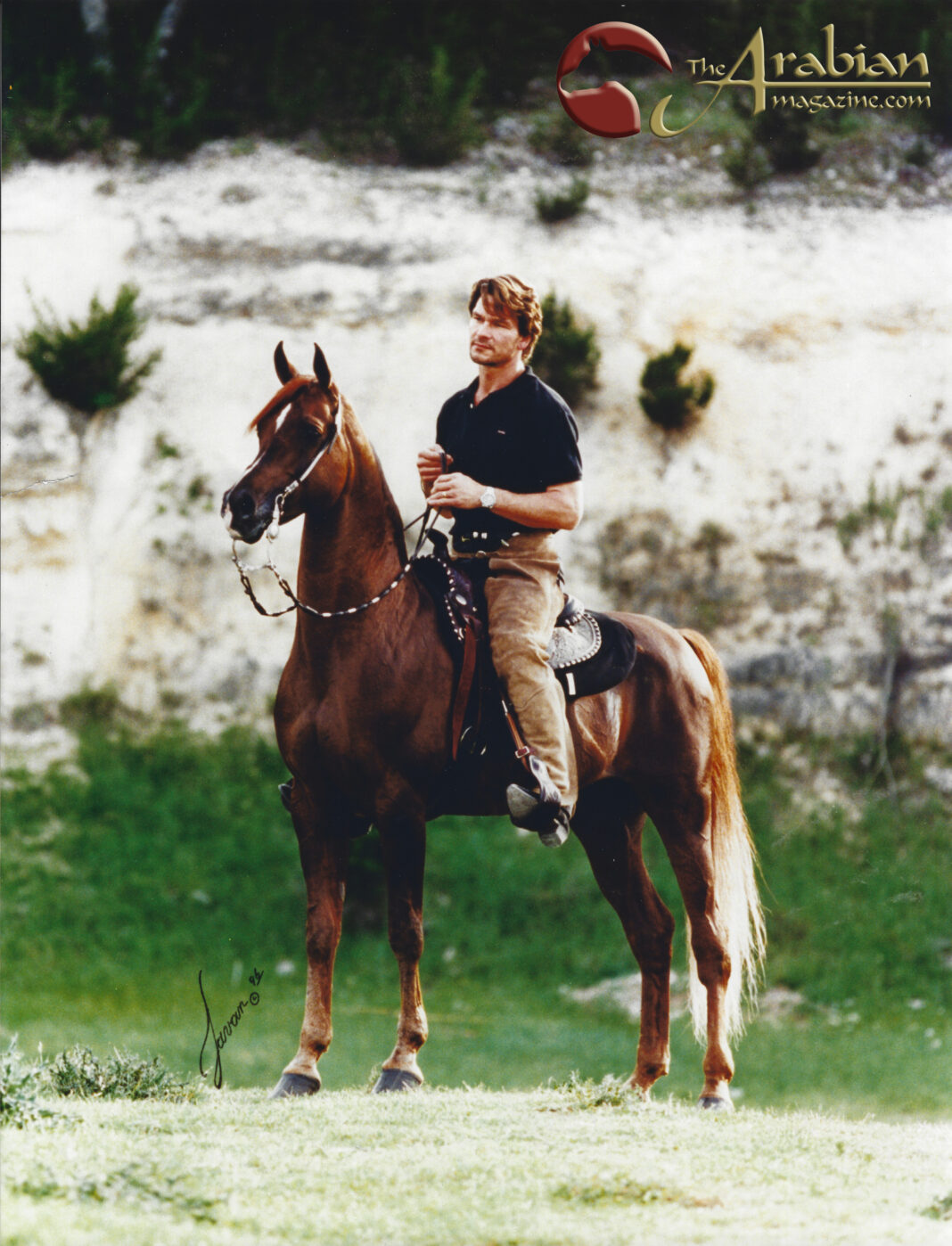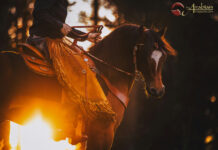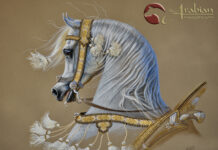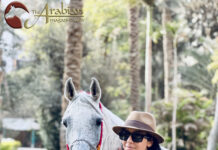“We breed Arabian horses because we want to continue a legacy that is hundreds of years old. That’s a heritage that deserves to be continued.”
Despite passing away in 2009, Patrick Swayze remains unforgotten. Most of the world thinks of him as a famous actor in films such as Dirty Dancing and Ghost plus the television series North and South. But Patrick had been also an avid Arabian horse enthusiast since his childhood.
As a little boy, Patrick visited the famous Gleannloch Farms in Texas, USA, and fell in love with the beauty of the Arabian horse. At Gleannloch Farms he also met the experienced horseman Tom McNair, who had been involved with Arabians since 1959. Trainer and manager at Gleannloch for 30 years, friends called Tom a walking encyclopaedia of Egyptian Arabian pedigrees. Tom worked also as a manager of Thistlewood Farms in Texas, and he was a recognised judge worldwide.
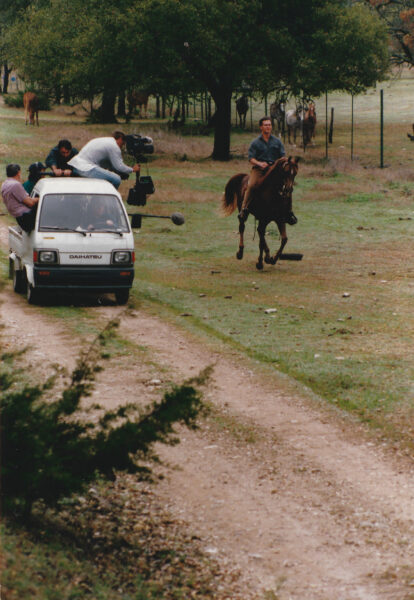
In 1972, Patrick married Lisa Niemi, a well-known actress of Finnish descent who also shared Patrick’s passion for the Arabian horse. One year, she gave Patrick a very special birthday present – the straight Egyptian stallion Tammen (Abenhetep x Talgansa). Tammen turned into an important cornerstone for Patrick and Lisa’s breeding programme, which was primarily based on straight Egyptian bloodlines.
In my interview with Patrick, made several years before he died, he and Lisa discussed their Arabian horses and talked about important factors in the handling, rearing and training of their horses. Interviewing these very special people was a unique experience, and their statements are now wonderful memories, giving unusual insights.
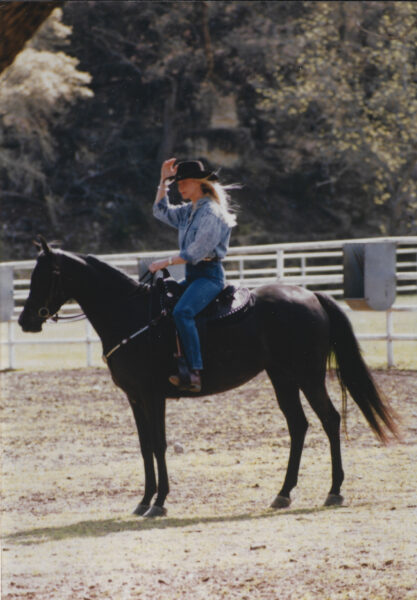
Judith Wenning: During your youth, you both visited the famous Gleannloch Farms owned by the Marshall family. What were your impressions?
Patrick Swayze: When I was a little boy, I always had the vision of a perfect horse who would be like a steed of the gods. I grew up with Quarter horses and Thoroughbreds. At Gleannloch Farms, I had the chance to meet the most beautiful horses I had ever seen in my life. Their elegance and intelligence impressed me very much.
Lisa Niemi: At this time, Tom McNair ran the farm, and his children took dancing lessons from Patrick’s mum while Patrick taught them swimming.
Patrick: That’s how I first met them, and we’ve remained friends ever since. When dignitaries, for example, the Egyptian President, Anwar Al Sadat, visited the Marshalls, they put on a horse show and my mother’s dance company performed. That was when I began dreaming about owning Arabian horses.
Lisa: “I first visited Gleannloch Farms with a theatre group when I was 12 years old. They gave us a short horse show, and I still remember how deeply impressed I was. It was years later that Patrick and I found out that we had been at the same place during our childhood.
Patrick: Furthermore, we both shared the same dream – Arabian horses!
Lisa: Yes, and now we own Arabian horses, and Tom is our mentor.
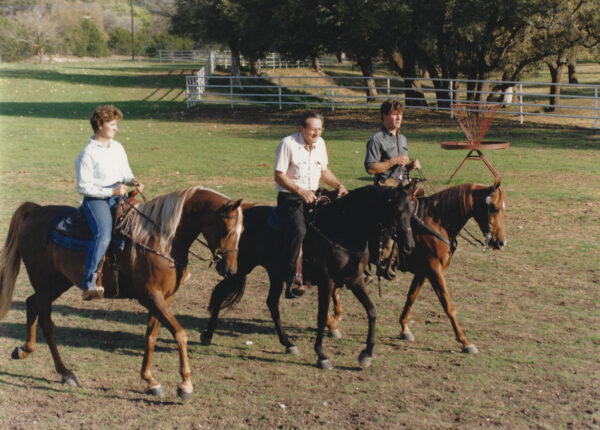
Judith: Did you see Morafic at Gleannloch Farms?
Patrick: Yes, I did. He is the first Arabian horse I ever saw – he was the reason I fell in love with these horses.
Judith: When did you buy your first Arabian?
Lisa: Our first Arabian was the gelding BR Ferouk Robert (Gai-Robert x Miss Imperial), purchased in 1986. He’s a Western Pleasure horse, very well trained, and after a little training with him, Patrick went Top Five at our first regional show and then Top Ten at the US Nationals – in his first year!
Patrick: We still have Robert. He’s a wonderful horse to ride.
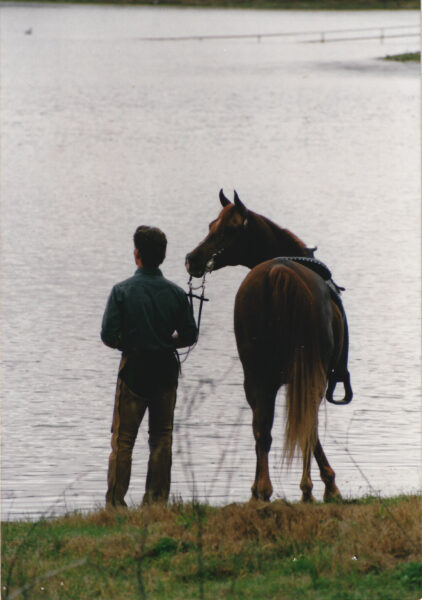
Judith: How many horses do you have at your farm, Rancho Bizarro, in California?
Patrick: At the moment we have eight, but we would like to bring a few more here to California. We have built a really nice facility, including a 16-stall barn, a round yard and two arenas.
Lisa: Although it’s very small here, we can take care of the horses properly. We have a lot of acres of the National Forest to ride in right behind the house.
Patrick: Tammen and all our breeding and show horses stay with Tom McNair at Thistlewood Farms in Kerrville, outside of San Antonio. Lisa and I became aircraft pilots a while back so that we can fly a high performance twin-engine as a team. Now we can fly to a horse show a few days earlier and start training the horses. It means so much more to us not to just own these horses, but to learn and to show them ourselves. You have to try to really understand the mind of the horse and to learn how to communicate with them. Every horse is different. You have to stay constantly inventive with Arabians because they figure out the system and become bored.
Lisa: They are wonderful to work with – challenging and wonderful but challenging in a good way. We have recently purchased a ranch in New Mexico with large pastureland but want to say where!
Patrick: Ultimately, we will move there, but we will always keep our major horses with Tom McNair – he’s our guru.
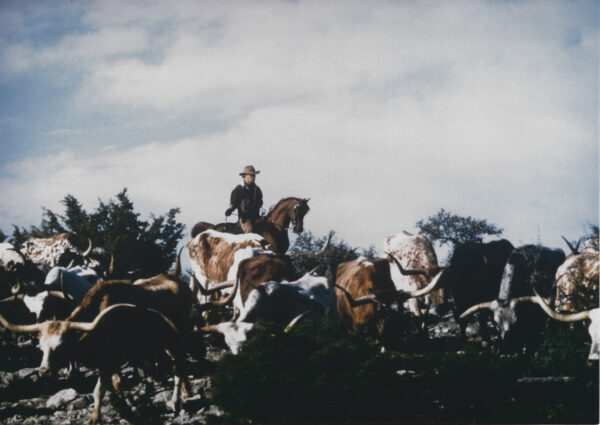
Judith: So, Tom McNair has taught you a lot?
Patrick: Tom has taught us everything over the past twenty years. We’ve got better and better to the extent that we now train our young horses.
Judith: Do you have a favourite horse?
Patrick: That’s hard to say, but it has to be Tammen. He’s our star, and he knows it.
Lisa: Tammen loves showing off for people.
Patrick: But he also has a kind heart and a real gentle nature, which he passes on to his foals. I have dreamed of having a bond with a special horse for all these years, and Tammen really is that horse. Moreover, that’s the wonderful thing about showing horses because it’s really about the horse, not about you and your little ego. It’s about how good a job you can do to give this horse the chance to be the best it can be.
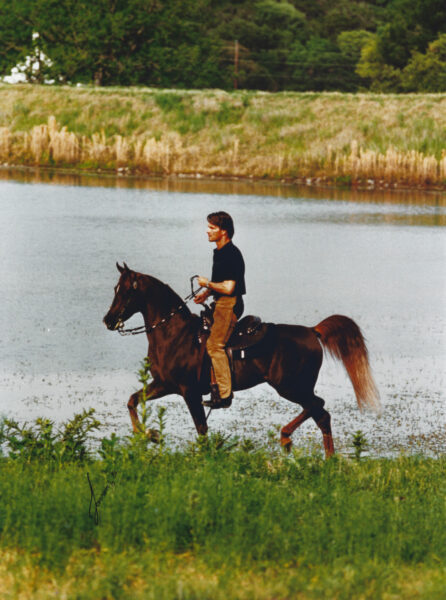
Judith: Tell us something about your everyday life. How much time do you spend with your horses?
Lisa: That varies.
Patrick: We have a groom whom we trained in our style, so he’s able to keep working with the horses when we are out of town.
Lisa: Our life is not routine at all. We travel a lot, to the Middle East for example, or for our careers. It’s always nice to get back to the horses because they’re grounding in their way. After Hollywood premieres and a lot of public appearances, we particularly love to be back with our horses again.
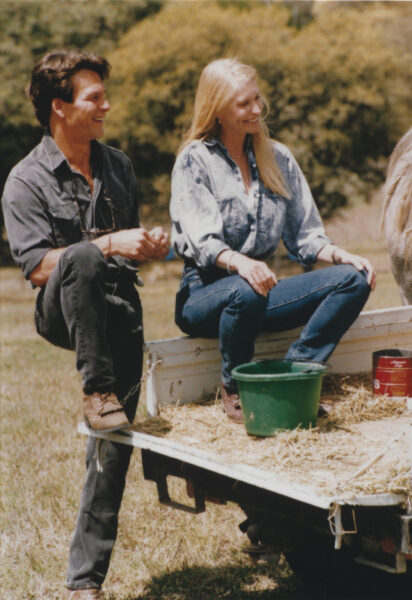
Judith: Which moments do you enjoy most with your Arabians?
Patrick: I think the moments which we enjoy the most are when we learn more from Tom, whom we call our ‘Papa Tom’. This man has probably forgotten more than most people will ever know about the Arabian horse. I’m sure every Arabian horse lover knows exactly what I’m talking about – the more you learn about horses, the more you realise what you don’t know.
Judith: What motivates you to breed Arabians?
Patrick: We love the horses, but we don’t love the business. We breed Arabian horses because we want to continue a legacy that is hundreds of years old. That’s a heritage that deserves to be continued. Our fear is that horses may disappear from our society because they’re no longer absolutely necessary. When something ceases to have a use, it usually disappears. Hopefully, more and more horse people will stay true to that passion and not let these beautiful creatures disappear from the face of the earth like so many other things have done.
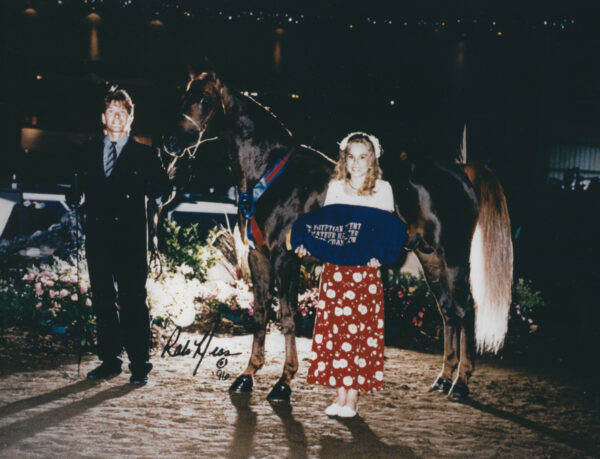
Judith: You like going to Arabian horse shows. Do you prefer halter or performance classes?
Patrick: Well, that’s an interesting question. Halter is very political, but we got involved with horses to get away from the political world of the movie business. That’s why we love performance a lot more.
Lisa: And actually, the people who are showing performance are having a lot more fun than those showing at halter!
Patrick: Although I must admit, that was a really big moment for Tammen and me when we went Grand Champion in Amateur Owner at Scottsdale!
Judith: Do you prefer certain bloodlines?
Patrick: We breed straight Egyptians. Sometime ago we did some experiments with breeding our stallion to mares from other horse breeds. It was very interesting, for instance, to see a Tammen foal out of a big Tennessee Walker mare.
Lisa: Our personal eye loves the refinement and the beauty, but you have to breed for athleticism and movement as well. By the way, we don’t do anything artificial with our horses in order to change their tail carriage or movement. When people look at our horses and see a beautiful tail carriage and beautiful movement, I want them to know that our horses have it because it’s in their breeding, not because we did something artificial.
Patrick: We are not interested in Arabians for the sake of winning. We want to constantly breed a better and more beautiful horse, based on Morafic (Nazeer x Mabrouka) and Nazeer (Mansour x Bint Samiha) bloodlines.
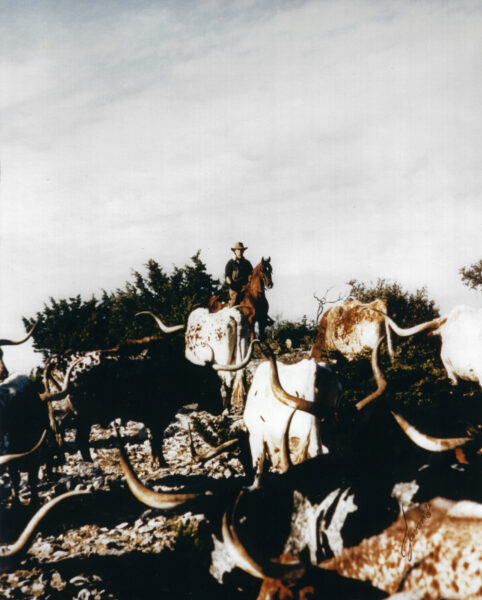
Judith: How do you select breeding horses? Which criteria are most important to you?
Patrick: The first thing that comes to my mind is, does the pedigree of this horse show that it can reproduce what you are hoping to accomplish? For example, when we breed a mare from the Sakr (Sultan x Enayat) line to Tammen, it is not absolutely necessary that she has perfect type because we know that Tammen will usually take care of that. But the bloodlines of this mare say that she should be very, very athletic and have beautiful movement. Sakr was famous for these traits.
Lisa: The more you learn about breeding Arabians, the more you can foresee which traits may be hereditary.
Judith: I recently saw an educational video in which you showed a lot of sympathetic understanding for a little foal. Is this gentle manner of dealing with horses a philosophy for you?
Lisa: Yes, absolutely. We love working with the foals. When your horse reacts in a different manner to what you expect, at first you have to question yourself and not the horse. You have to train yourself at least as much as you train your horse. I think this manner of dealing with horses is very different compared to the methods used by other people.
Judith: Finally, what are your plans for the future?
Lisa: Have fun and learn more.
Patrick: And keeping on trying to breed the most beautiful horses we possibly can.


